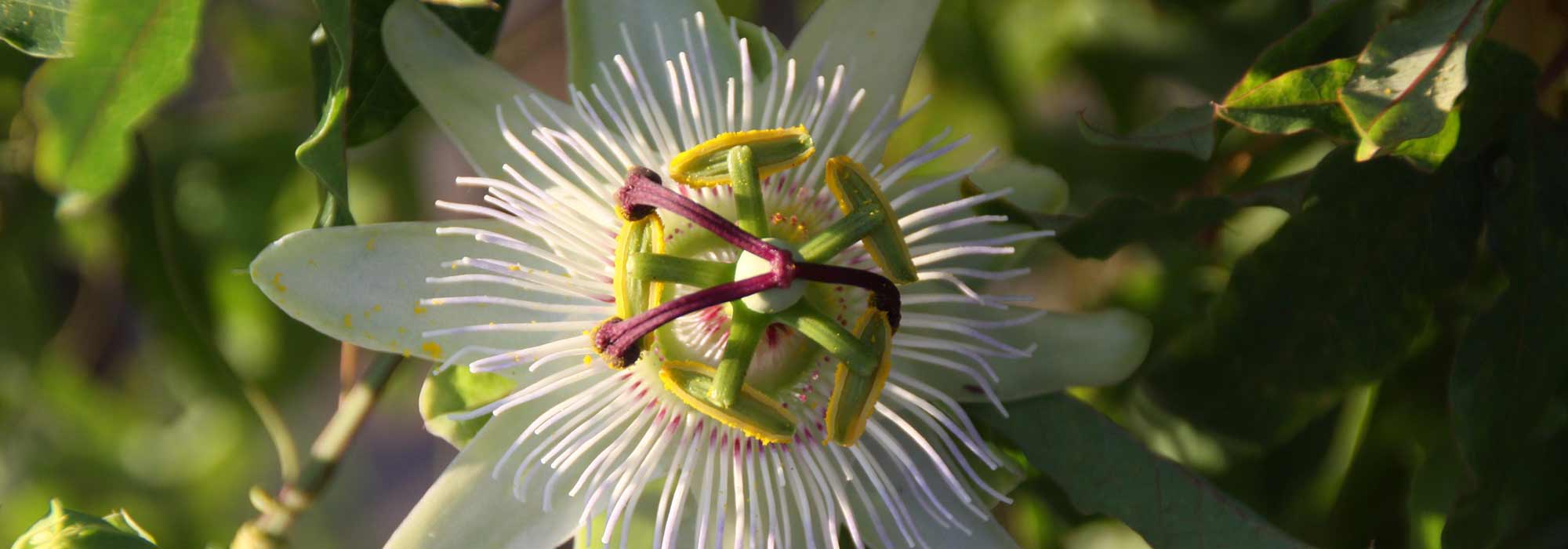
Diseases and pests of passion flowers
Identification and treatments
Contents
The passion flower is a plant that generally withstands diseases well. However, numerous factors, including the proliferation of pest insects such as aphids, leaf miners, and bugs, can contribute to the spread of viral, bacterial, or fungal diseases. Among these are passion fruit woodiness, brown spot, root and collar rot, fusarium wilt, and scab.
Here’s how to recognise and treat diseases and pests of passion flowers naturally.
The brown spot of passion flower
Brown spot is a fungal disease caused in passion flower by the fungus Alternaria pasiflorae, whose development is particularly favoured by high humidity.
Symptoms
Alternaria pasiflorae causes the appearance of reddish-brown spots on the leaves of the passion flower. Over time, these round, zoned spots can reach a diameter of 2 cm. Fine black masses composed of spores, located in the middle of the lesions, can also be observed. This phenomenon is then quickly followed by intense defoliation of the plant. Elongated and dark brown lesions on the stems can in turn lead to the death of the terminal part of these organs. The disease also manifests on ripe fruits, where circular and reddish-brown spots with dark green, greasy margins are observed, which even affect the pulp of the fruit.
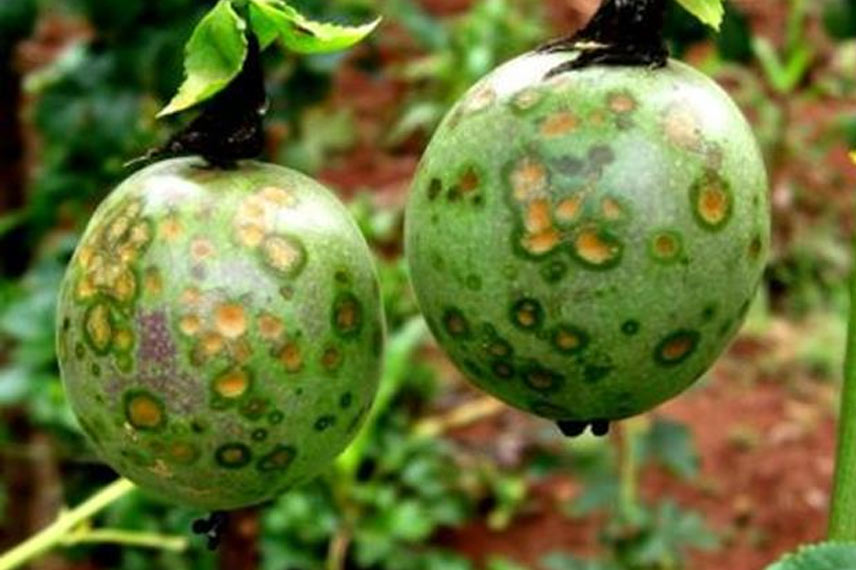
Brown spot, Alternaria pasiflorae – Photo: AA-Seif, icipe.
Treatments
- To limit the risk of infection, avoid watering your passion flowers by spraying. Ensure that you only water the base of the vine.
- Make sure your passion flowers benefit from rich soil to ensure their good health.
- In case of an established disease, immediately remove the affected parts using well-disinfected tools. Then spray a garlic decoction on the plant to eliminate the fungus.
The scab of passion flower
The fungus Septoria passiflorae is responsible for passion flower leaf spot. Prolonged rain and mild temperatures greatly favour the development of this disease.
Symptoms
Leaf spot primarily affects the leaves of the passion flower, manifesting as light brown, round necrotic spots surrounded by a chlorotic halo. These spots cause rapid and premature leaf drop from the passion flower. Lesions may also be observed on young shoots, leading to wilting and death of their tips. The flowers can also exhibit lesions similar to those on the leaves, resulting in their early drop. Finally, the fruits can be affected at any stage of their development.
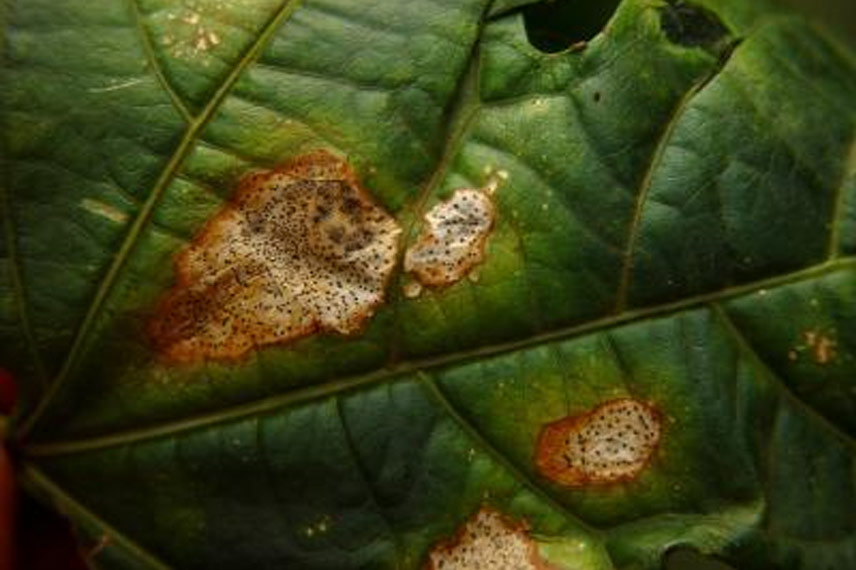
Passion flower leaf spot, Septoria passiflorae – Photo: AM Varela, icipe.
Treatments
Preventive and curative measures for Brown Spot also apply to leaf spot.
Discover other Passionflowers
View all →Available in 0 sizes
Available in 0 sizes
Available in 0 sizes
Available in 0 sizes
Available in 1 sizes
Available in 1 sizes
Available in 1 sizes
Available in 2 sizes
Available in 1 sizes
Available in 2 sizes
Phytophthora rot
Phytophthora rot, Phytophthora cinnamomi and Phytophthora nicotianae, is a disease particularly prevalent in clay soils that manifests during warm periods (between 26 and 30°C) and heavy rainfall.
Symptoms
Root and collar rot is characterised by slight chlorosis followed by wilting, defoliation, and the death of the passion flower. Cracks in the bark are particularly evident at the collar of the plant. Infected leaves exhibit a burnt appearance with a coppery colouration, while flowers drop prematurely. On the fruits, large watery spots and a greyish-green colour may also be observed. Often, the affected parts emit a foul odour.
Treatment
- Ensure to remove plant debris from the garden to limit the spread of this fungus’s spores.
- When detected early, Phytophthora rot can be treated with Bordeaux mixture.
Read also
Growing a passionflower in a potFusarium wilt
The fungus Fusarium oxysporum is responsible for fusarium wilting. This disease is transmitted through soil movement and by runoff or irrigation water. The severity of symptoms increases in sandy soil, under high temperatures coupled with certain humidity levels.
Symptoms
Symptoms of fusarium wilting first appear as a slight wilting of passion flower vines, followed by their general yellowing and eventual death. Meanwhile, the vascular system of the plant darkens at the level of its roots, collar, stem, and branches.
Treatment
Once established, the disease is rarely controllable and you will be forced to uproot the entire plant.
Aphids and viruses
The CMV (Cucumber mosaic virus) and woodiness virus are transmitted to passion flower through attacks by aphids, Aphis gossypii. They most often manifest on the young organs of the plant. These viral diseases typically appear after pruning periods and just before flowering.
Symptoms
The CMV manifests as the appearance of yellow spots randomly distributed on the lamina of the leaves of passion flower. The woodiness virus causes a significant reduction in plant development, and its leaves exhibit an unusual mosaic and roughness, as well as severe distortion. The fruits produced are then woody and deformed. Ultimately, the viruses lead to premature death of passion flower plants.
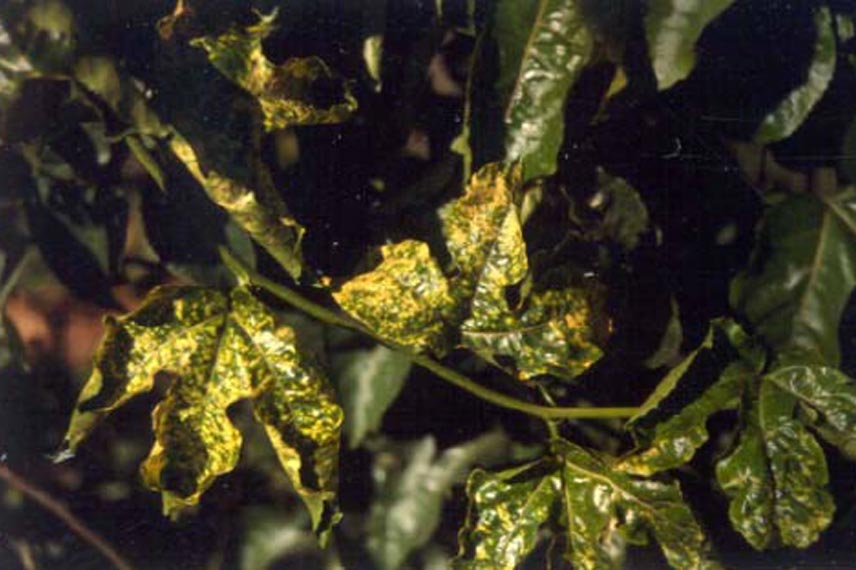
Cucumber mosaic virus – photo: I. Fischer and J. Rezende.
Treatment
- To naturally control aphid infestations, ensure you provide a biodiversity-rich environment for your passion flowers, which will support the presence of their natural enemies, beneficial insects (hoverflies, ladybirds, lacewings, etc.)
- Black soap is effective in combating aphid attacks.
- Unfortunately, there is no curative treatment for plants affected by a virus. Infected passion flowers must be removed without being propagated.
Stink bugs
Stink bugs have a nasty tendency to pierce young plants of passion flower. These are particularly to be feared in dry and hot weather.
Symptoms
The bite of stink bugs causes sometimes deformations of the plant and the fruits of passiflora. They can also lead to rotting, or even the decline of the plant.

Punctate Green Stink Bug, Nezara viridula
Treatment
- In very dry weather, spraying with water helps to drive away the stink bugs.
- Soap sprays help to easily regulate the population of stink bugs.
Leaf miners
Leaf miners, Liriomiza trifolii, lay their eggs on passion flower leaves, where their larvae cause significant damage, especially to young plants.
Symptoms
The larvae of leaf miners grow and move by tunnelling inside the leaves, reducing their surface area. Their presence can particularly favour the development of fungal diseases.
Treatment
- As with aphids, the presence of beneficial insects helps to regulate the population of leaf miners.
- Subscribe!
- Contents


































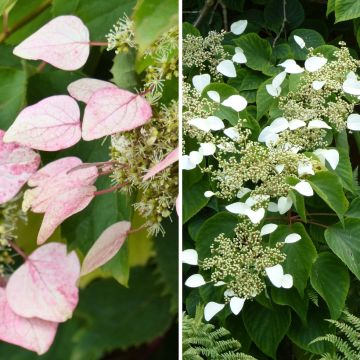

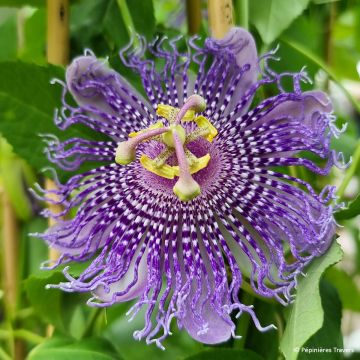


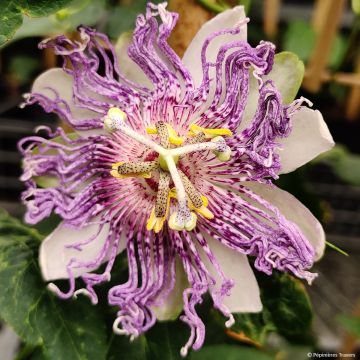
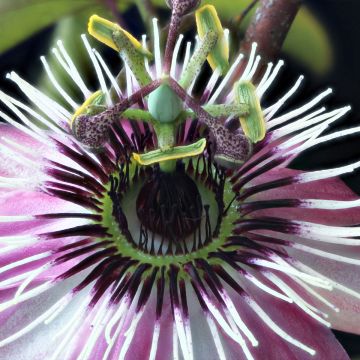

Comments